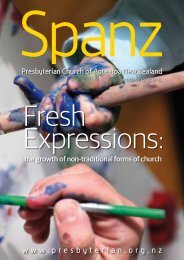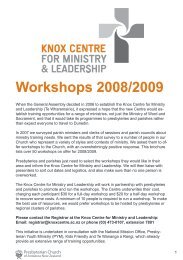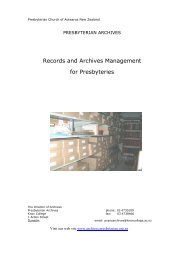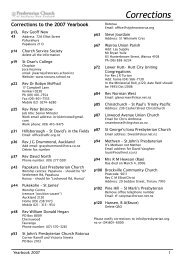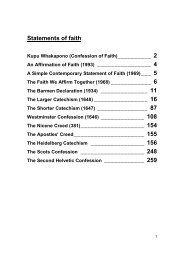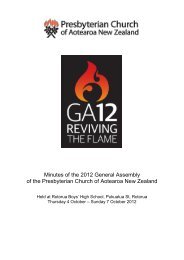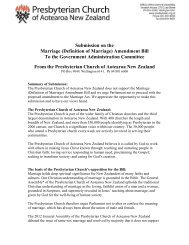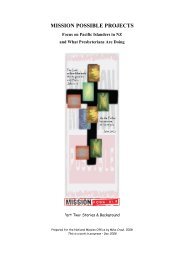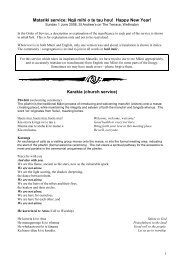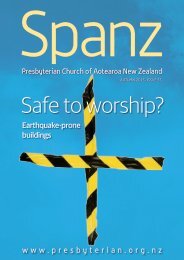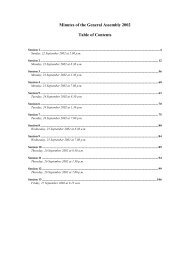Cultural diversity and unity in Christ: the Presbyterian Church of ...
Cultural diversity and unity in Christ: the Presbyterian Church of ...
Cultural diversity and unity in Christ: the Presbyterian Church of ...
Create successful ePaper yourself
Turn your PDF publications into a flip-book with our unique Google optimized e-Paper software.
e <strong>Christ</strong>ianised it must be by <strong>the</strong> Ch<strong>in</strong>ese’.” 22 McGavran developed this <strong>in</strong>sight on <strong>the</strong> mission field<br />
<strong>in</strong> India, but it was picked up by <strong>the</strong> church growth movement <strong>in</strong> <strong>the</strong> US <strong>and</strong> applied to church life<br />
<strong>the</strong>re. <strong>Church</strong> growth <strong>the</strong>ory was based on <strong>the</strong> social reality that people f<strong>in</strong>d it easier to go to church<br />
with people just like <strong>the</strong>mselves <strong>and</strong> this became built <strong>in</strong>to all <strong>the</strong> church market<strong>in</strong>g ideas. So most<br />
“successful” churches became based on some version <strong>of</strong> <strong>the</strong> homogeneity pr<strong>in</strong>ciple. The pragmatism<br />
<strong>of</strong> our culture <strong>the</strong>n assumed that if it works <strong>in</strong> br<strong>in</strong>g<strong>in</strong>g people <strong>in</strong>to church it must be good. Questions<br />
were not <strong>of</strong>ten asked as to whe<strong>the</strong>r it was consistent with <strong>the</strong> gospel or not, a question we will soon<br />
pick up.<br />
However even pragmatically <strong>in</strong> <strong>the</strong> k<strong>in</strong>d <strong>of</strong> <strong>in</strong>creas<strong>in</strong>gly multicultural or multiethnic societies we live<br />
<strong>in</strong> it becomes questionable whe<strong>the</strong>r it holds perhaps <strong>the</strong> same valency, particularly once an immigrant<br />
group moves beyond <strong>the</strong> first generation. When I was visit<strong>in</strong>g <strong>the</strong> UK <strong>in</strong> 2000 Peter Brierley, who<br />
heads up <strong>Christ</strong>ian Research <strong>the</strong>re, told me <strong>in</strong> an <strong>in</strong>terview with him that he could describe where <strong>the</strong><br />
church was grow<strong>in</strong>g <strong>in</strong> one word; “black”. He said as you traced changes <strong>in</strong> <strong>the</strong> level <strong>of</strong> church<br />
attendance <strong>in</strong> those counties where it <strong>in</strong>creased it was where <strong>the</strong> percentage <strong>of</strong> <strong>in</strong>habitants came<br />
<strong>in</strong>creas<strong>in</strong>gly from black immigrant communities. However whereas <strong>in</strong> <strong>the</strong> 1970s <strong>and</strong> 80s it was with<br />
those from <strong>the</strong> Carribean, <strong>in</strong> <strong>the</strong> 1990s <strong>and</strong> <strong>in</strong>to <strong>the</strong> 21 st century, as those communities moved <strong>in</strong>to <strong>the</strong><br />
second generation, it was with <strong>the</strong> new immigrants from Africa. Now over 50% <strong>of</strong> church attenders <strong>in</strong><br />
London are <strong>of</strong> ei<strong>the</strong>r Carribean or African ethnicity. The po<strong>in</strong>t he was mak<strong>in</strong>g, though, is that well<br />
identified <strong>in</strong> sociological studies that as <strong>the</strong> comm<strong>unity</strong> moves through <strong>the</strong> generations <strong>in</strong> <strong>the</strong> new l<strong>and</strong><br />
so people become more like <strong>the</strong> host comm<strong>unity</strong>, especially <strong>the</strong> young people, <strong>and</strong> <strong>in</strong> <strong>the</strong> UK, as <strong>in</strong><br />
NZ, regular church <strong>in</strong>volvement is not one <strong>of</strong> <strong>the</strong>ir characteristics. This shows up <strong>in</strong> statistics on<br />
church <strong>in</strong>volvement among young Pacifica people raised <strong>in</strong> NZ (<strong>the</strong> 1.5 generation) <strong>and</strong> <strong>in</strong>creas<strong>in</strong>gly<br />
those born <strong>in</strong> NZ. This was discovered <strong>in</strong> a study <strong>of</strong> <strong>the</strong>se among Pacific Isl<strong>and</strong>ers by Jemaima<br />
Tiatia 23 <strong>and</strong> a fur<strong>the</strong>r study <strong>of</strong> Cook Isl<strong>and</strong> churches 24 found a significant proportion had left those<br />
churches for similar reasons as were identified <strong>in</strong> research <strong>of</strong> European church leavers’ <strong>in</strong> NZ by Alan<br />
Jamieson 25 . Cluny MacPherson <strong>in</strong> study<strong>in</strong>g Samoan adolescents <strong>and</strong> young adults found <strong>the</strong>y became<br />
<strong>in</strong>creas<strong>in</strong>gly impatient with “<strong>the</strong> adherence to traditional forms <strong>and</strong> styles <strong>of</strong> worship <strong>and</strong> a<br />
gerontocratic pr<strong>in</strong>ciple <strong>of</strong> leadership that denied <strong>the</strong>m a voice <strong>in</strong> <strong>the</strong> church’s decision mak<strong>in</strong>g<br />
process.” 26 This ties <strong>in</strong> with Ebaugh’s f<strong>in</strong>d<strong>in</strong>gs <strong>of</strong> <strong>the</strong> major problems second generation members<br />
confront <strong>in</strong> <strong>the</strong> <strong>the</strong>ir parent’s churches <strong>in</strong> <strong>the</strong> US:<br />
(a) many feel estranged by <strong>the</strong> ethnic ambience <strong>of</strong> <strong>the</strong> immigrant congregation, <strong>in</strong>clud<strong>in</strong>g heavy use <strong>of</strong><br />
old-country language<br />
(b) <strong>of</strong>ten <strong>the</strong> young adopt [western]ised attire <strong>and</strong> demeanour that <strong>the</strong> older generation def<strong>in</strong>es as<br />
improper <strong>and</strong> <strong>of</strong>ten comment on negatively<br />
(c) sometimes religious services are def<strong>in</strong>ed by youth as too rigid <strong>and</strong> old fashioned<br />
(d) <strong>in</strong> some religious <strong>in</strong>stitutions adult second generation members are denied mean<strong>in</strong>gful<br />
participation <strong>in</strong> congregational affairs <strong>and</strong> access to authority roles to which <strong>the</strong>y feel entitled. 27<br />
As well as those who left church altoge<strong>the</strong>r, what is also evident is that many o<strong>the</strong>rs who have left <strong>the</strong><br />
Pacific Isl<strong>and</strong> ethnic churches have moved to multiethnic churches, particularly Pentecostal <strong>and</strong><br />
charismatic churches. Yannick Fer, a French sociologist, has carried out considerable research on<br />
religious change among young Pacifica people, <strong>and</strong> found that <strong>in</strong> NZ many had moved to Pentecostal<br />
churches which provided a way for <strong>the</strong>m to rema<strong>in</strong> with<strong>in</strong> <strong>the</strong>ir traditional faith (<strong>Christ</strong>ianity) <strong>and</strong> yet<br />
22 Alex<strong>and</strong>er Don, “Our Ch<strong>in</strong>ese Mission,” The NZ <strong>Presbyterian</strong>, October 1, 1884, 64.<br />
23 Jemaima Tiatia, Caught Between Cultures: A New Zeal<strong>and</strong> Born Pacific Isl<strong>and</strong>s Perspective (Auckl<strong>and</strong>:<br />
<strong>Christ</strong>ian Research Association, 1998).<br />
24 Tokerau Joseph, Cracked Coconuts: An exploration <strong>of</strong> why young Cook Isl<strong>and</strong>ers are leav<strong>in</strong>g Cook Isl<strong>and</strong><br />
congregations <strong>of</strong> <strong>the</strong> <strong>Presbyterian</strong> <strong>Church</strong> <strong>of</strong> Aotearoa New Zeal<strong>and</strong>, MTh <strong>the</strong>sis, University <strong>of</strong> Otago, 2005.<br />
25 Alan Jamieson, A <strong>Church</strong>less Faith (Well<strong>in</strong>gton: Philip Garside Publish<strong>in</strong>g, 2000).<br />
26 Cluny Macpherson <strong>and</strong> La’avasa Macpherson, “Evangelical Religion Among Pacific Isl<strong>and</strong> Migrants: New<br />
Faiths or Brief Diversions”, Journal <strong>of</strong> Ritual Studies 15 (2), 2001, 31.<br />
27 Ebaugh, “Religion <strong>and</strong> New Immigrants”, 235.<br />
9



